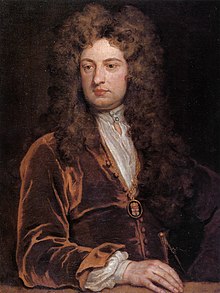Kit Cat Club

The Kit Cat Club was an early 18th century London club that organized numerous Whigs members who were politically and artistically active.
Goals and members
Politically, the club advocated a strengthening of parliament, the restriction of the absolute monarchy, the resistance of the British crown against France and its political system and a Protestant successor to the British throne. Outwardly, the club emphasized its role as a social meeting place. In the club u. a. William Congreve , Joseph Addison , the painter Godfrey Kneller , John Vanbrugh and politicians like Marlborough , Charles Seymour , Thomas Pelham-Holles and the temporary Prime Minister Robert Walpole .
history
The Vanbrugh biographer Downes speculates that the origins of the Kit-Cat Club go back to the times before the Glorious Revolution that brought James II to the throne of England through William III. was replaced. Downes quotes the Whig historian John Oldmixon, who knew many of those involved in the coup and noted that many of the later club members would often meet in a bar before 1689 to chat.
Writer Horace Walpole , son of Kit Cat Club member Robert Walpole , alleged that the respectable senior members, commonly described as salon lions, "were in fact the patriots who saved Britain," implying that the Club members were the real driving force behind the Glorious Revolution. Political conspiracies of this kind are usually poorly documented, so that here too it will probably remain a matter of speculation.
Club member Godfrey Kneller created a total of 48 portraits of members of the club in over 20 years. These paintings make up the most complete membership list of this club today. All paintings are 36 by 28 inches (that's roughly 90 by 70 cm); they are now in the National Portrait Gallery in London.
Name of the club
The club's name is traced back to Christopher Cat, or Kit Cat for short, who owned a restaurant on Shire Lane near Temple Bar and whose mutton patties were known as Kit-Cats.
The KitKat chocolate bar is said to be derived from the name of this club.
literature
- Kerry Downes: Sir John Vanbrugh. A biography . Sidgwick and Jackson, London 1987, ISBN 0-283-99497-5 .
